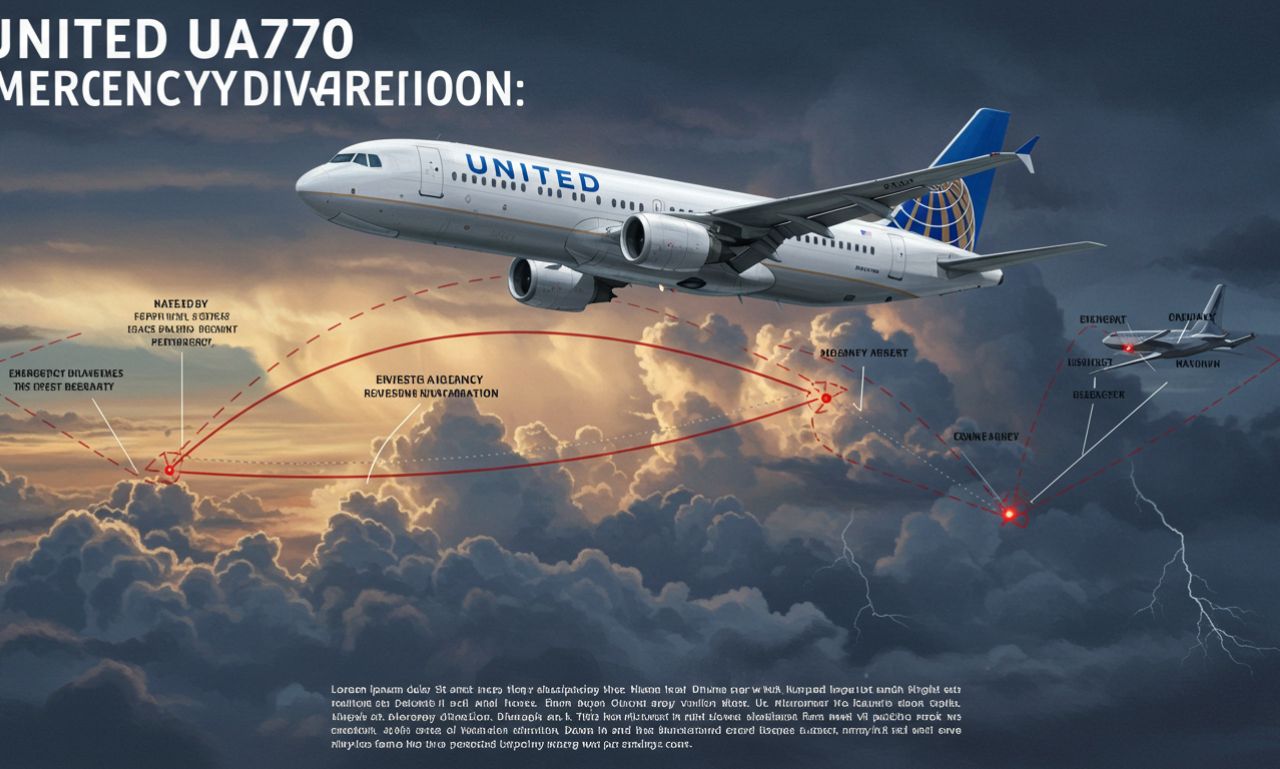On July 22, 2025, United UA770 Emergency Diversion faced an unexpected emergency in midair. What began as a routine transatlantic flight turned into a tense diversion when the crew detected a technical anomaly. With swift decisions and calm execution, the flight was rerouted and landed safely at London Heathrow Airport. All 257 passengers and 12 crew members were unharmed.
fety systems—and the critical importance of training, protocols, and coordination in aviation emergencies.
Flight UA770 Route & Aircraft Details
Flight UA770 was operating on a long-haul route from Barcelona (BCN) to Chicago O’Hare (ORD). The aircraft was a Boeing 787-9 Dreamliner, a modern wide-body jet known for its efficiency, advanced systems, and long-range capability.
,000 feet—the crew noticed irregularities suggesting a cabin pressurization issue. Though the situation had not yet deteriorated into a decompression event, the warning indicators were serious enough to trigger a general emergency declaration via transponder code 7700.
Because of the anomaly, the pilots diverted to Heathrow. Heathrow was chosen due to its strong infrastructure, emergency readiness, and ability to handle large international aircraft under pressure.
Timeline of the Emergency Diversion
Here’s how the incident appears to have unfolded:
-
About 90 minutes into the flight, the crew detected a pressurization warning.
-
The captain declared an emergency (squawk 7700) and coordinated with air traffic control.
-
The flight was rerouted to London Heathrow as the safest available airport. Emergency services were on standby at Heathrow as the plane approached.
-
UA770 landed safely on Runway 27R at 4:55 PM BST.
-
Passengers and crew disembarked without injury; no oxygen masks were deployed.
This chain of events underscores the professionalism and readiness of the flight crew and ground teams.
What Caused the Diversion?
The preliminary investigation points to a cabin pressurization system anomaly as the root cause. Though the issue did not escalate into full decompression, such warnings are taken extremely seriously because they affect life support systems and structural integrity.
The Boeing 787-9 is equipped with redundant systems and continuous monitoring. The fact that the crew detected the anomaly early likely prevented escalation into more dangerous failure.
Official regulatory bodies—such as the FAA in the U.S. or EASA in Europe—are expected to conduct detailed inspections of the pressurization systems, maintenance records, and sensor systems to find the exact trigger.
Crew Response & Protocols
One of the most commendable aspects of the event was how the flight crew handled it:
-
Quick Decision-Making: Upon detecting the anomaly, the pilots and systems monitoring teams rapidly assessed risk and chose diversion over continuing the route.
-
Clear Communication: Passengers reported the crew kept them informed, minimizing panic or confusion.
-
Standard Procedures: The crew followed emergency checklists, prepared the cabin, coordinated with ATC, and landed safely.
-
Calm Presence: Many passengers noted that the crew remained composed, aiding in reassuring everyone onboard.
These are textbook examples of airline crew training in action. In emergencies, how the crew reacts often determines outcomes as much as mechanical systems do.
Passenger Experiences and Aftermath
Passengers shared mixed emotions—initial concern, but also relief and respect for the crew’s handling of the situation. Some took to social media praising the transparency and calm aboard UA770.
After landing, United UA770 Emergency Diversion assisted passengers with hotels, meals, and rebooking to their final destinations. The airline confirmed that the aircraft would undergo a full inspection before returning to service.
In official statements, United emphasized passenger safety as its top priority. The airline also pledged to cooperate with regulatory investigations.
Broader Context: Emergency Diversions in Aviation
Emergency diversions are rare but not unheard of. Airlines and regulatory authorities maintain strict procedures precisely for these moments. Situations that commonly prompt diversions include:
-
Mechanical or system failures (hydraulics, pressurization, engines)
-
Medical emergencies onboard
-
Weather or turbulence issues
-
Security or threat concerns
In every case, prioritizing safety over schedule or cost is foundational. Flight UA770’s diversion is a real-world demonstration of that principle.
Lessons for the Aviation Industry
From this incident, several key lessons emerge:
-
Early detection is crucial — Modern aircraft systems can generate pre-failure warnings that allow safe diversion before escalation.
-
Crew training matters — The ability to act decisively and clearly under pressure is essential.
-
Coordination across systems — Air traffic control, ground emergency teams, and airline operations must sync for optimal outcomes.
-
Passenger communication is vital — Keeping passengers informed helps reduce fear and confusion.
-
Maintenance vigilance — Regular inspection of pressurization and structure systems may prevent similar anomalies.
Regulatory Response
Following such emergencies, aviation authorities typically initiate investigations. For UA770:
-
The FAA (or equivalent national body) may review maintenance logs, sensor data, and pilot actions.
-
EASA or European regulators may also participate, especially since the landing was in London.
-
The manufacturer (Boeing, in this case) will likely analyze component and system health to determine commonalities or design vulnerabilities.
These investigations can lead to service bulletins, revised inspection protocols, or software updates to prevent recurrence.
Why Heathrow Was Ideal for Diversion
Heathrow remains one of the world’s best-equipped airports for handling aircraft emergencies:
-
Extensive emergency response infrastructure (fire, medical, rescue)
-
Instrument Landing System (ILS) and runway capabilities for large jets
-
Close proximity to European air routes
-
Efficient coordination with ATC, ground services, and regulatory bodies
For UA770, Heathrow offered a safe, capable landing site with minimal delay and maximum support.
Safety & Trust in Modern Air Travel
Despite the stress such occurrences create, they also reinforce trust in air travel safety. The fact that 257 passengers and 12 crew members emerged unscathed from a mid-air emergency speaks volumes about aviation systems, redundancy, and training.
For average travelers, the takeaway is clear: airline emergencies are rare, but when they occur—even in transatlantic flights—protocols exist, and professionals are trained to handle them.
Conclusion
The United Airlines Flight UA770 emergency diversion is a stark reminder of the complex, layered safety mechanisms present in modern aviation. A pressurization alert triggered swift action, a carefully chosen diversion, and a safe landing in London—all without harm to those onboard.
This incident reaffirms that while air travel is inherently complex, it remains safe thanks to rigorous training, technological backstops, and global coordination. Though inconvenient for passengers, for UA770 the priority remained clear: safety above all.


